If you want a complete system (with frame), see our post about the best paint roller setup (with the frame or cage). This post here discuss the roller cover.
The best paint roller cover:
- What surfaces will I paint?
- Do I care about the stippled look of the dried paint?
Also, below is the step-by-step ‘how-to’ and these 2 important tips:
- What is backrolling—(saves paint)
- Why we roll before the cut—(saves time)
Key tip: The best paint roller cover will save you money and time.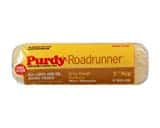
If you just want the bottom line here at the top, the best product is the Purdy Roadrunner, because of it’s longevity (the poly), and ability to hold paint (the wool), it’s a great deal. This is definitively the best paint roller cover for interior and exterior.
Almost all the tools that we use to apply paint are made by the excellent brands Wooster or Purdy—Rock and Roll.
Here’s the biggest tip I can give:
Higher-quality actually costs less: Paint dissolves the glue in ‘low-end’ roller covers making the fibers shed. This results in a wall with fuzz all in it. Ick. The best paint roller covers are woven, not glued to the plastic cylinder at the core.
Want to see the whole set up? Here’s what we recommend for the best paint roller system (roller frame, pole, and accessories).
Bottom line: nothing we use costs that much more than the ‘budget’ all-in-one kits paint stores try to sell. Those rollers shed lint and drag you down! One rare exception is the Purdy roller/brush/pan kit. It’s great.
Composition of Roller Covers
 All covers shown here work for oil and latex paints.
All covers shown here work for oil and latex paints.
My top tool: the 50/50 — Wool/Poly blend shown above. Why?
Hands down the 50-5 is the best paint roller cover for painting almost everything. We use the 50/50 almost exclusively because I want value. The polyester gives a long life and the wool holds a great amount of paint: less time dipping.
- As I said above, the best product is the Purdy Roadrunner because of its longevity and speed, it’s a great deal. This is definitively the best paint roller cover for interior and exterior basic wall and trim painting. Yes, trim: we use the roller to apply and the brush to ‘tip-out’ the paint on all trim. Read the article on this.
Runner-up: Wool only.
Holds a great amount of paint but does not last as long as the type blended with Polyester.
Honorable mention: Polyester only.
Great longevity, but does not hold much paint. Easy to clean.
Foam: just like pillow foam and leaves a very smooth finish. Really only for doors, trim, some floors.
Mohair: Old school. Angora mixed with polyester: leaves a very smooth finish and short paint roller nap. Great for enamels, varnishes, urethanes, and epoxies, but the above rollers work for these also.

 Paint Roller Nap Basics:
Paint Roller Nap Basics:
What is paint roller nap? It’s the absorbing material:
Composition (above) and length are all you need to know.
Pros use the 1-inch (or longer) almost always: the stipple is pleasing enough and long nap holds a lot of paint. Go with this or ½-inch or ¾ unless you have a reason not to.
Shorter paint roller naps—Holds less paint but make more smooth surfaces, more uniform stipple in latex walls. Some customers care about the stipple marks the roller leaves. Hmm. Ok customer.
Remarks:
Smoother surfaces can look too stippled with a long nap, so as John Travolta says, Get Shorty. Nice video break. Ah.
Longer paint roller naps—Holds more paint, rougher surfaces, stipple is more like a rag mark.
Tip for Rough surfaces: they require a long nap that you can push into the cracks (don’t get an inexpensive roller frame (a.k.a. cage) for this—they snap right in-two.
Choosing a paint roller nap length:
1/4 – and 3/16 – inch nap for smooth or fine surfaces, such as doors and trim (yes, semi-gloss)
3/8 – inch nap for smooth walls and ceilings (see our post on the best ceiling paints)
1/2 – inch nap for most walls and medium rough surfaces
3/4 – inch nap for rough surfaces, such as textured walls and ceilings
1- up to 1.5 – inch nap: For rough surfaces like stucco or a heavily textured ceiling and concrete
Even though the above is what is correct, still we use 3/4 or 1″ in apartments and homes: it’s a rougher stipple marking, but we can go faster and give a better price to the customers.
Best paint roller covers: shapes/sizes
Standard 9-inch. Used 99% of the time.
Below this section, we simplify the many options. ( Canadian? Read this. )
Big Boy on the Block: the 18-inch pro. It’s very heavy, but very, very fast. We used to have teams of 2 guys, each doing 2 apartments PER DAY. At 3 to 4 hundred each… just do the math. 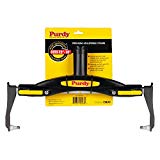
The 18 is really only for pros, but if you have a lot of painting coming up, go for it. Talk about how to paint a wall with a roller!
You need this special wide bucket and here is the Purdy 18-inch roller frame. Of course, the roller covers kicks butt.
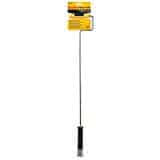 Mini Roller Covers; Here is a good purdy mini roller that is very long and narrow. The mini is good for behind toilet etc, and standard cylinder size only 3 or 4-inch good for trim, small projects.
Mini Roller Covers; Here is a good purdy mini roller that is very long and narrow. The mini is good for behind toilet etc, and standard cylinder size only 3 or 4-inch good for trim, small projects.
Textured wall roller covers
1- Drywall texture roller: Textured walls are acoustically more pleasing (quiet), but expensive to have done professionally. A pro will load thinned ‘mud’ into a sprayer (a contraption with a big hopper) and spray globs onto unsanded drywalls before priming. (You can have patterns and even buy this in a can!) There is a better way: I have never tried it but this guy seems to know what he’s doing. The texture roller cover you need is here. Good luck! Let me know how it goes!
This roller leaves a pattern called Tree Bark—very nice. Also, choose from:
- Goop
- Poinsettia
- Crow’s Foot
- Serengeti
- BasketWeave
2- Paint pattern roller: These are a new style roller product and it can make designs for you, but make sure you want to live with this for a long time! It’s a lot like wallpaper: just easier and more fun to apply. Here are some products to have a look at. Each page shows a sample of a painted result. This video shows (start at 4:00) the roller working.
Remarks:
My recommendation for patterns: even the specialty roller cover will not do what a specialist painter can do for you. Pros use cloth, sponges etc: they are true artists. They make paint look like marble.
3- Do what the pros do for about 35 bucks
Landladies and lords take note: save your beat-up walls with texture. You don’t need the big machine: this is an all-in-one unit: electric motor sucks in the air you need. Brilliant idea. Has 3 tips for the main texture types you see. Watch the video on the product page. I added this one onto my wish-list. If you want to do what the big boys do, search my site for sprayers: a world of fun.
Finally, a dishonorable mention:
Painting Pads: not recommended
Remarks:
A way to ‘brush’ edges. This is nothing like the best roller covers and brushes: but this holds little paint, does not apply evenly (except on TV). If you really want to try, here is the best of the lot.
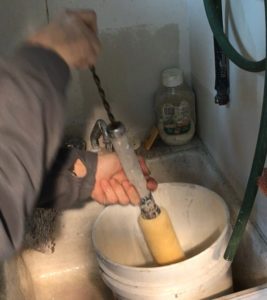
Cleaning the Best Paint Roller Covers
(Read our complete post How to Clean Paint Rollers)
“Clean up is a drag”…Not !
- To remove roller cover from the roller frame you can bang on the edge of a bucket (cover it with a large rag: it splatters). Do this before it can dry and glue the paint roller cover to the frame.
- After squeezing* most of the paint out of your roller (use your 3rd hand tool), soak your latex roller in a large bucket of water overnight. This makes the remaining paint fall out to the bottom.
- In the morning, discard the water and repeat. After you get most of it this way, just squeegee with your hands under water. It gets clean by itself… takes time though.
- You only need to get about 95% of the paint out and a quality paint roller cover will still live a long time. (Not true for oils).
- A high-quality paint roller cover has a plastic core and will not be harmed by soaking. I have soaked the best paint roller for weeks with no problems.
- Watch me use a spinner and get it over with. (If you’re into it, buy that spinner here.)
- They say you need soap. No. Soap is not really necessary (except for some sticky red and yellow pigment), but warm water does speed up the process. The best roller covers can really bounce back.
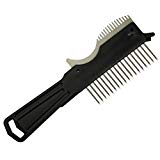 This cleaning tool is a roller squeegee tool and brush comb. I keep this at my garage sink: very handy. The brush comb on the other edge is for AFTER you clean your brush: comb them straight to dry like new. (p.s. little known tip: you don’t need soap, but a little hair conditioner on your brush gives longevity).
This cleaning tool is a roller squeegee tool and brush comb. I keep this at my garage sink: very handy. The brush comb on the other edge is for AFTER you clean your brush: comb them straight to dry like new. (p.s. little known tip: you don’t need soap, but a little hair conditioner on your brush gives longevity).
Using oil-based paints? We almost never ever clean a roller with oil-based paints. We did ONCE UPON A TIME, but it’s just too long of a process and when a ‘clean’ roller cover dries, it still has oil and stays crusty. Luckily, oil-based paints are almost a thing of the past. When we must roll oil, we select an old, used up wool/poly roller cover then throw it away. RIP, Krusty the Clown.
Just one mo’ time: Even if you don’t plan to use these tools again, buy the best paint roller cover on the market. Save your money.
Ask me anything. No account needed to comment below!
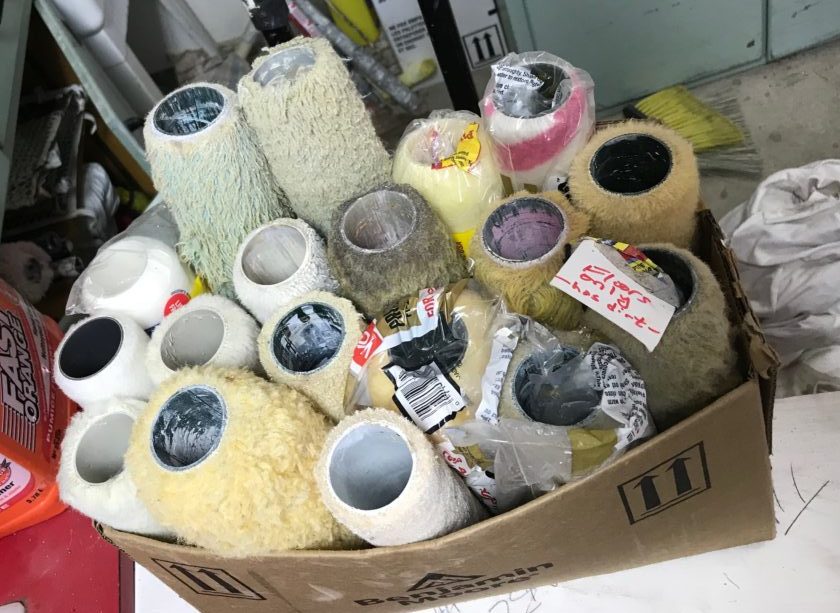

Hi, what is the best roller cover for stucco and the best brush to cut corners in stucco. Using latex paint. My husband will paint our house in a month but he never do this kind of job. He painted inside but I think painting the exterior is different and i want the best tools. also it is true that foggy days is not good to paint? People told me that weather is important when paint a wall or house. I live in Canada.
WEather is key of course. Wet is a killer for painting.
Use a long nap, mabye 3/4 inch and Purdy brush on my tools page.
Get the paint into all the nooks and crannies!
B
How do you store your brushes?
Is there a special container you use? Thank you so very much for your extremely helpful posts and videos!!!
I use Purdy brushes almost exclusively. WHen clean, I simply comb them with the brush comb and let dry with the bristles STRAIGHT. They are like new next time.
Thanks for the nice words.
b
I’ve had to, before this website, throw out SO many different paint roller cover because they always seemed to run out of durability within a few jobs. After reading your post on how to completely clean them (and picking up a spinner!) I can safely say that my roller cover’s lifespan has increased almost 10x!
You suggest INSL-X Tough Shield floor paint for basement floors but I cannot find it anywhere!
Hi. Here is the page with the link at the top. Just click on the photo… Most Ben Moore stores will have it…but it’s free shipping, and same cost online. If I misunderstood, let me know…
B
Hi, We are getting ready to paint our new interior doors, jambs and trim. They are the six paneled wood textured doors. We like the smooth look (not stippled). Do you recommend the Purdy 1/4 roller over spraying? Should we use a brush on the trim? Thank you.